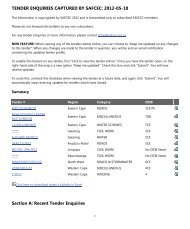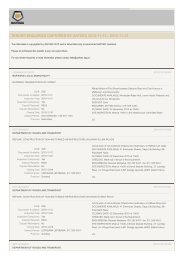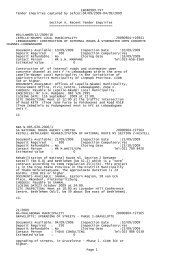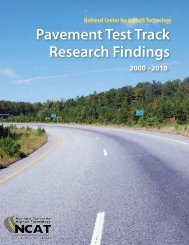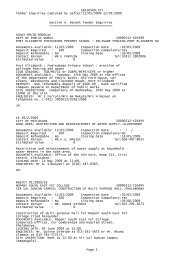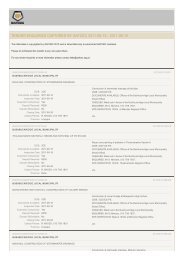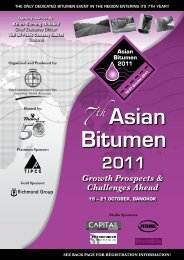DIGEST 2006 - Sabita
DIGEST 2006 - Sabita
DIGEST 2006 - Sabita
You also want an ePaper? Increase the reach of your titles
YUMPU automatically turns print PDFs into web optimized ePapers that Google loves.
ecommendations (R69/97 for<br />
bituminous mix design) involves<br />
an analytical study prior to<br />
verification by mechanical testing.<br />
This analytical study is supported<br />
by a software package called<br />
PRADO (Programmes for Asphalt<br />
Mix Design and Optimisation).<br />
This method aims to achieve the<br />
best possible compromise between<br />
various (and sometimes<br />
conflicting) requirements such as<br />
dealing with both resistance to<br />
fatigue and rutting of the mix. In<br />
Volumetric and mastic<br />
evaluation of dolerite and<br />
quartzite mixes:<br />
Theoretical volumetric calculations<br />
using PRADO software were done<br />
for both the designs incorporating<br />
both dolerite and quartzite. The<br />
results of the volumetric analysis<br />
(estimating VIM, VMA and the<br />
filler/binder ratio - by both mass<br />
and volume – and the stiffening<br />
effect of the mastic) over a range<br />
of binder contents were calculated<br />
as follows:<br />
Dolerite<br />
Quartzite<br />
Binder content (%)<br />
4<br />
4.5<br />
5<br />
5.5<br />
4<br />
4.5<br />
5<br />
5.5<br />
Estimated VIM (%)<br />
PRADO<br />
7.7<br />
6.5<br />
5.3<br />
4.1<br />
6.2<br />
5.1<br />
4.0<br />
2.9<br />
VIM (%) laboratory<br />
7.7<br />
5.4<br />
4.0<br />
3.6<br />
6.8<br />
4.9<br />
3.2<br />
1.5<br />
Estimated VMA (%)<br />
PRADO<br />
VMA (%) laboratory<br />
Filler/binder ratio (by<br />
mass)<br />
Filler/binder ratio (by<br />
volume)<br />
T R&B increase (mastic vs<br />
binder)<br />
17.1<br />
17.5<br />
1.4<br />
0.49<br />
11.9<br />
17.1<br />
16.7<br />
1.24<br />
0.44<br />
10<br />
17.1<br />
16.5<br />
1.12<br />
0.39<br />
8.7<br />
17.1<br />
17.4<br />
1.02<br />
0.36<br />
7.7<br />
15.3<br />
15.7<br />
15.9<br />
0.60<br />
21.7<br />
15.3<br />
15.1<br />
1.41<br />
0.53<br />
17.4<br />
15.3<br />
14.7<br />
12.7<br />
0.48<br />
14.6<br />
15.3<br />
14.4<br />
1.16<br />
0.43<br />
12.5<br />
Table 2: PRADO Mix Design Estimates Versus Actual Volumes<br />
this approach, the stability of the<br />
mix can be ensured by making use<br />
of intergranular friction while<br />
avoiding overfilling the mineral<br />
skeleton with mastic (i.e. with<br />
filler and binder). This mastic<br />
should only fill part of the voids in<br />
the mineral aggregate and should<br />
also have the right consistency<br />
(i.e. the correct proportion of filler<br />
and binder).<br />
Dolerite aggregate evaluation<br />
results<br />
In general the estimated VIM and<br />
VMA values as predicted by<br />
PRADO are slightly higher than the<br />
values obtained in the laboratory.<br />
From Table 2 it can be seen that<br />
the increase in the Ring & Ball<br />
temperature of the mastic<br />
105



